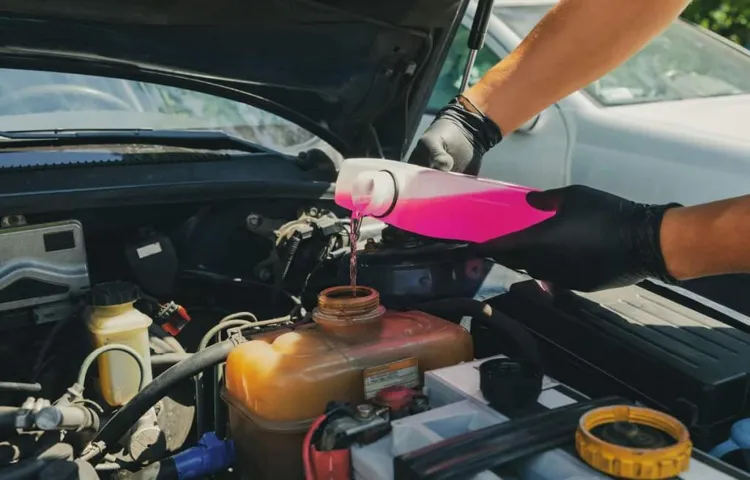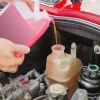Have you ever been in a situation where you needed to check your coolant level, but weren’t sure how long to wait before opening it? It can be a tricky task, but it’s important to make sure your coolant levels remain at the appropriate level to keep your engine running smoothly. In this blog, we’ll dive into the details of how long you should wait before opening your coolant, why it’s important, and what can happen if you don’t. So, grab a cup of coffee, sit back, and let’s get started!
Table of Contents
Understanding coolant systems
When it comes to opening a coolant system, it’s important to know how long to wait before doing so. If you open the system too soon, you risk getting burned by the hot coolant or causing damage to the engine. Generally, it’s recommended to wait at least 30 minutes after the engine has been turned off before attempting to open the coolant system.
This allows sufficient time for the engine to cool down and the pressure to equalize within the system. However, it’s always best to consult your vehicle’s manual for specific instructions on the proper procedure for opening the coolant system. By following the recommended wait time, you’ll not only stay safe but also maintain the health of your engine’s coolant system for the long run.
Types of coolant systems
Coolant systems are an essential component of vehicles, and understanding the different types can help ensure that your vehicle runs smoothly. The two most common coolant systems are air-cooled and water-cooled. Air-cooled systems work by circulating air through cooling fins on the engine to dissipate heat.
Water-cooled systems, on the other hand, use a liquid coolant to remove heat from the engine, which is then circulated through a radiator to release the heat. Water-cooled systems are the most common in modern vehicles and are typically more efficient at regulating engine temperature. Other types of coolant systems include oil-cooled and hybrid systems that combine elements of both air and water cooling.
Regardless of the type of coolant system your vehicle uses, it’s important to keep it well-maintained to ensure optimal performance and prevent overheating. Regular coolant flushes and inspections can go a long way in maintaining the health of your coolant system.
Coolant system components
Coolant systems are a crucial component of any car’s engine. They keep the engine from overheating by regulating its temperature. The components of the coolant system include the radiator, the water pump, the thermostat, and the hoses that connect them all.
The radiator helps to dissipate heat by passing coolant through a series of thin fins, which help to cool it down before it returns to the engine. Meanwhile, the water pump circulates coolant through the engine, removing excess heat and maintaining a consistent temperature. The thermostat helps to regulate the amount of coolant flowing through the system, ensuring that the engine runs at an optimal temperature.
Proper maintenance of these components is essential to keep your engine cool and running smoothly. A malfunctioning coolant system can lead to engine failure, so it’s important to have it inspected regularly and replace any faulty components. By taking care of your coolant system, you can ensure that your car runs at its best for years to come.
The importance of waiting
When it comes to opening the coolant system, waiting is crucial. Your car’s engine generates a significant amount of heat, and the coolant works to prevent overheating. But after driving, the coolant can reach extreme temperatures, and prematurely opening the system can lead to burns and injuries.
As a general rule, it’s recommended to wait at least 30 minutes before attempting to open the coolant system. Waiting allows the system to cool down and reduces the risk of injury. It’s also important to remember to check the manufacturer’s recommendations for your specific vehicle, as wait times can vary depending on the make and model.
Although it may feel frustrating to wait, taking the time to let the coolant system cool down before opening it can prevent injury and ensure the continued smooth operation of your car.
Coolant temperature
When it comes to engine maintenance, there are a few things that we often overlook. One of those things is the importance of waiting for your coolant temperature to stabilize before shutting down your engine. You may think that turning off your engine as soon as you park is no big deal, but the truth is that it can cause serious damage.
When your engine is running, your coolant is circulating to keep your engine from overheating. If you shut down your engine before the coolant temperature stabilizes, the coolant can stop circulating, and your engine can overheat. This can cause damage to your engine, and in severe cases, it can even cause your engine to seize up.
So, the next time you park your car, take a few extra minutes to let your engine cool down before shutting it off. Your engine will thank you for it!
Coolant pressure
When it comes to coolant pressure in your car, patience can be a virtue. It’s important to wait until your engine has cooled down before checking or adding coolant. Why? Well, if you open the coolant cap while the engine is still hot, the pressure inside the system can cause hot coolant to spray out, potentially causing burns or serious injury.
It’s also important to wait before adding coolant, as pouring cold liquid into a hot engine can cause damage to the engine block or even cause the coolant to boil over. So, as tempting as it may be to take a peek under the hood right after you’ve shut off the engine, it’s best to wait until it’s had some time to cool down first. Being patient can save you from a lot of potential headaches down the road.
Potential hazards
When it comes to potential hazards, waiting can be of utmost importance. Rushing into a situation without taking the time to properly assess for hazards can lead to severe consequences that could have been avoided. Take driving, for example.
It may be tempting to speed through a yellow light, but this impatience could result in a devastating car accident. Similarly, setting up a ladder without ensuring it is secure and on level ground could lead to a dangerous fall. By taking just a few moments to evaluate a situation and waiting to proceed until it’s safe, we can greatly reduce the risk of hazardous situations.
In all aspects of life, it’s important to put safety first and take the time to properly assess for potential hazards.
Determining wait time
Figuring out how long to wait before opening your coolant system can be a little tricky, but it’s important to wait until the engine has fully cooled down. Typically, you should wait at least an hour or two after turning off your engine. It’s important to keep in mind that different factors can affect the wait time.
If you were driving at high speeds or towing something heavy, your engine will be hotter and require more time to cool down. Additionally, if you were in a hot climate or idling for an extended amount of time, your engine will also require more time to cool down. It’s crucial to wait until the engine has cooled down to avoid injury from hot coolant or steam.
By waiting the appropriate amount of time, you ensure your safety and avoid any potential damage to your engine.
Manufacturer’s recommendations
When it comes to determining the wait time for a manufactured product, it’s crucial to follow the manufacturer’s recommendations. These recommendations can be found in the product’s instruction manual or on the manufacturer’s website. By following their guidelines, you can ensure that you don’t damage the product or nullify any warranties by using it before it’s ready.
The wait time can vary depending on the type of product and the manufacturer, but it’s typically based on factors such as temperature and humidity. It’s essential to understand that the wait time is necessary to allow the product to cure or dry fully. Rushing the process could result in a weaker or defective product, which can be dangerous depending on what it’s used for.
So, be patient and follow the manufacturer’s recommendations to ensure that your product performs as expected and lasts as long as possible.
Conditions affecting wait time
When it comes to determining the wait time for a particular service or product, there are a number of factors that can come into play. One of the most significant is the overall level of demand for that service or product. When demand is high, wait times are likely to be longer, as providers work to accommodate as many customers as possible.
Another key factor to consider is the complexity of the service or product being offered. Services or products that are more complex are likely to take longer to complete, leading to longer wait times for customers. Additionally, the availability of staff and resources can have a major impact on wait times, as businesses that are short-staffed or lacking in certain resources may struggle to keep up with demand.
Ultimately, understanding the factors that contribute to wait times can help businesses better manage their operations and provide customers with a more streamlined and efficient experience.
Conclusion
So, how long should you wait before opening your coolant? Well, much like love, patience is key. You want to give your engine and its components the time they need to cool down and settle before you go poking around under the hood. So, take a deep breath, count to 10 (or maybe 100), and resist the urge to open that coolant cap until you’re absolutely sure it’s safe to do so.
After all, a little patience now can save you a lot of frustration (and potentially expensive repairs) down the road. Remember, good things come to those who wait – even when it comes to engine coolant.”
FAQs
How long should I wait before opening the coolant after turning off my car?
It’s recommended to wait at least 15 minutes after turning off your car before opening the coolant reservoir to avoid any potential burns from hot coolant.
Can I check my coolant level when the engine is hot?
No, it’s not recommended to check the coolant level when the engine is hot as it can cause burns and distort the accuracy of the reading. Wait until the engine has cooled down before checking the coolant level.
How often should I change my coolant?
It’s recommended to change your coolant every 2-5 years or according to the manufacturer’s recommendation. However, check your owner’s manual for the specific interval for your vehicle.
What type of coolant should I use for my car?
Check your owner’s manual for the recommended coolant type before adding any to your vehicle. It’s essential to use the correct type of coolant to avoid damage to your engine.
Can I mix different types of coolant?
No, it’s not recommended to mix different types of coolant as it can cause chemical reactions and damage to your engine. Stick to the recommended coolant type for your vehicle.
How do I know if my coolant is low?
Check the coolant level in the reservoir tank. If it’s below the minimum mark, the coolant is low, and you need to add more.
Can I use water instead of coolant in my car?
No, it’s not recommended to use water instead of coolant in your car as it doesn’t provide the same level of corrosion protection for your engine as coolant does. Water also freezes at a higher temperature than coolant, which can cause damage in cold weather.



